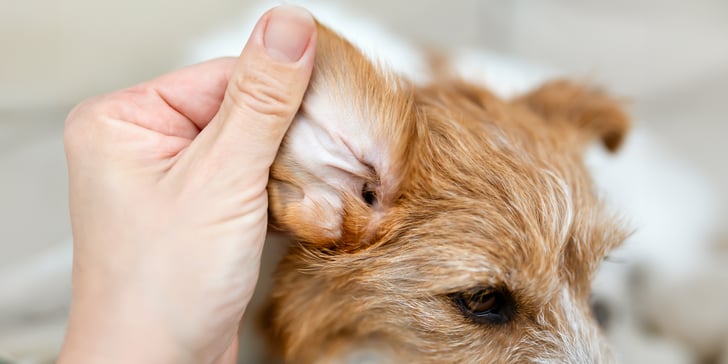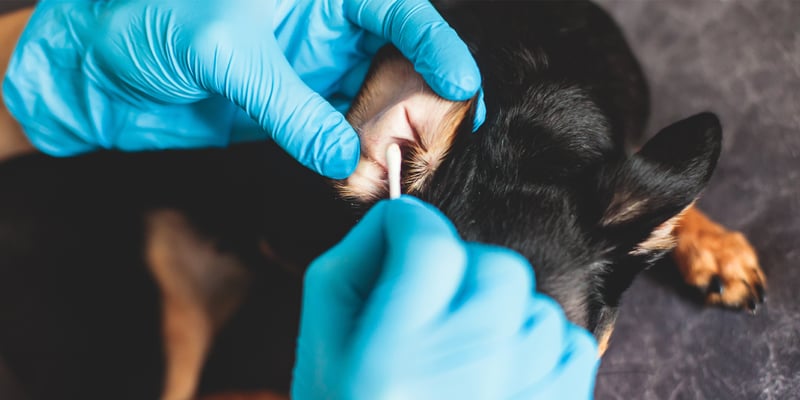How to Clean Your Dog’s Ears Safely and Effectively
Index:



Introduction
The task of maintaining your pet's well-being includes the often-overlooked necessity to clean your dog's ears.
Not merely a cosmetic concern, this chore is important to ward off potential complications such as infections, ensuring they can hear their favourite sounds without discomfort.
The secret to a proper cleaning process lies in using the correct techniques, coupled with a reliable dog ear-cleaning solution advised by veterinarians.
Whether you are administering ear drops, checking the eardrum, or maintaining a routine of ear cleanings, doing it right is crucial to maintain ear health and promote ear health.
Always prioritise gentle methods to safely clean and respect the delicate structure of your canine friend's ears.
With the right approach, you can keep your four-legged companion's hearing sharp and their clean dog ears in top shape.
Key takeaways
Regular ear cleaning is key to preventing ear problems and ensuring overall well-being.
Choosing the appropriate veterinary ear-cleaning solution is critical for a safe and effective cleaning.
Understanding the anatomy of your dog's ears helps to clean without causing harm.
Monitoring for any changes post-cleaning can help quickly identify and address potential ear issues.
It's essential to know when to seek professional help to avoid exacerbating any underlying conditions.
Determining when your dog needs ear cleaning
For conscientious dog owners, the well-being of their pets is paramount. This includes understanding when their canine companions require ear cleaning.
Not all dogs need their ears cleaned with the same frequency, and knowing what to look for is key to maintaining their ear health.



How to clean your dog's ears: a step-by-step guide
You can begin your dog's ear care with a distinct step-by-step guide designed to keep their ears clean and healthy.
Before you begin, it's important to gather the proper materials.
Start with a cotton ball or gauze, a reliable dog ear-cleaning solution excluding hydrogen peroxide - to avoid the risk of irritation- and a soft, dry towel to gently dry the ear afterward.
Commence by holding the ear flap firmly but gently to expose the inner part of the ear.
Carefully squeeze the bottle to release a veterinarian-recommended ear-cleaning solution into the ear canal.
This step is crucial for dogs, particularly those with a penchant for swimming, as moisture can often lead to infection without proper post-swim ear care.
With the cleaning solution in place, it's time to gently massage the base of the ear for a few moments.
This action helps to break up any accumulated debris within the ear canal and empowers the solution to work effectively.
Once completed, allow your dog to shake its head. This shaking is a natural reflex that facilitates the removal of the solution along with any loosened dirt and wax.
Gently hold the ear flap and wipe away loosened debris from the accessible parts of the ear and the upper ear canal using the cotton ball or gauze. It's imperative to be extremely careful not to insert anything too deep into the ear canal.
Observe your dog for any signs of discomfort. Should your pal exhibit any pain or unease, stop the process immediately and seek professional advice, as this might indicate an underlying issue.
Concluding the cleaning session involves a final gentle wipe to remove any additional cleaning solution or debris.
This ensures the ear is left clean, without over-insertion to avert unnecessary discomfort.
These ear care tips serve as proactive measures in maintaining your dog’s aural health.
Frequent checks for any indicators of pain or infection, which may cause irritation or lead to more severe complications, are as vital as the cleaning process itself.
Remember to maintain your dog's ear care routine systematically to forestall these risks and uphold their overall well-being.
Identifying ear problems in dogs
Examining the ear is a vital part of routine checks for any dog. Alertness to changes can help detect early signs of discomfort.
Dogs may shy away from touch if their ears are sensitive or sore, especially those with longer ears which are prone to ear infections.
An examination might reveal signs of ear issues, like wax accumulation or debris from the ear canal, indicating that it's time to clean their ears.
Certain breeds are more prone to ear infections, especially breeds with long ears or breeds with larger or pointy ears.
You may also misidentify an ear infection for something picked up while out on your regular walks.
Dogs who spend a lot of time outdoors can also suffer from itchy afflictions such as ear mites or fleas and ticks.



Understanding the importance of regular ear checks for canines
As a dog isn’t capable of verbal communication, regular ear checks by the owner become essential.
When checking your pet, dogs with healthy skin cells in their ears should not have a foul odour.
Any unusual smell or excessive scratching signals the need to examine the ear more closely and possibly clean it to remove any irritants or obstructions.
Recognising signs that suggest a need for ear cleaning
Recognising the signs of ear discomfort is crucial. Dog owners should be vigilant for excessive head shaking, or if the pet appears agitated when its ears are touched.
These signs of ear distress might suggest that the dog has an ear infection or that there's a buildup of debris and wax that requires attention.
Familiarity with the unique needs of each dog aids in ensuring that their ears remain clean and healthy.



When to consult a veterinarian for ear care
In situations where the presence of redness, inflammation, a stark odour, or your pet exhibiting signs of discomfort or distress, it's important to consult a veterinarian.
Veterinary expertise is fundamental, especially before attempting to clean a dog's ear that displays symptoms of an underlying issue.
This ensures you are equipped with the precise method and means to tackle a potential ear infection and to adeptly maintain your dog's ear health.
If you're a Waggel member, why not make use of Joii? They're an online vet care provider available to all Waggel members at no extra charge. Best of all, their consultations are unlimited and take place 24/7.



Conclusion
The vigilance in monitoring your dog's ears becomes imperative to maintaining ear health and preventing infections.
This ongoing surveillance aids in detecting early symptoms or changes that may allude to ear ailments.
A healthy ear is typically characterised by a pink hue, absence of any unpleasant scents, and no signs of inflammation or unnecessary grime.
To further enhance your understanding of your dog's health, consider exploring articles on topics like why dogs lick their lips and the benefits of dog supplements. These resources offer valuable insights into maintaining your pet's well-being beyond ear care.
FAQs
How can I safely clean my dog's ears?
To safely clean your dog's ears, you'll need an approved veterinary ear-cleaning solution and some cotton balls or gauze. Avoid harsh substances like hydrogen peroxide which can cause irritation.
Gently fill the ear canal with the solution, massage the base of the ear to loosen debris, and allow your dog to shake its head.
Finish by gently wiping away the loosened debris and excess solution from the ear's outer folds, being cautious not to insert anything deep into the canal.
How often should I clean my dog's ears?
The frequency of ear cleanings varies from dog to dog. Breeds that are prone to ear infections, have floppy ears, or those that swim often might require weekly cleanings.
In contrast, dogs with upright ears may need less frequent care. It's essential to observe your dog and clean their ears as needed, looking out for wax accumulation or debris.
What are the signs that my dog may need their ears cleaned?
You might need to clean your dog's ears if you notice any unusual odour, excessive wax, debris, inflammation, or if your dog is shaking its head more than usual.
If your dog appears to be in pain or discomfort when their ears are touched, it may indicate an ear problem and a veterinary check is advised.
What should I avoid when cleaning my dog's ears?
Never use cotton-tipped swabs or insert anything far into your dog's ear canal, as this can push debris deeper and cause trauma to the delicate structures inside, including the eardrum.
Additionally, avoid using solutions that are not specifically designed for dogs as they can cause irritation or inflammation.
Can I use home remedies, like hydrogen peroxide, to clean my dog's ears?
It's inadvisable to use hydrogen peroxide for cleaning your dog's ears as it can cause irritation and dry out healthy skin cells.
Always opt for a veterinary-approved ear cleaning solution that is gentle yet effective for maintaining your dog's ear health.
What should I do after cleaning my dog's ears?
After cleaning, continue to monitor your dog's ears for any signs of irritation or infection.
If you notice any redness, swelling, or if your dog continues to display signs of discomfort, contact your veterinarian.
Regular checks will help to maintain your dog's ear health and identify any issues early on.
Why is it important to clean my dog's ears?
Cleaning your dog's ears is important to remove wax and debris which can lead to ear infections.
Regular cleaning also allows you to monitor your dog's ear health and catch any potential problems early.
Clean ears are key to preventing painful infections and promoting overall ear health.
When should I take my dog to the veterinarian for ear problems?
If your dog's ears appear red and inflamed, have an unpleasant smell, or if your dog is showing signs of pain and discomfort, you should take them to see a veterinarian.
Also, seek professional help if you're unsure about how to clean your dog's ears or if you suspect an infection or the presence of ear mites.
Waggel Pet Insurance
Need more help? You're in luck if you're a Waggel Pet Insurance member. Along with our excellent coverage, we offer access to a 24/7 online vet to answer all your sticky questions, especially if you need grooming assistance.
Not a member? Why not get a quote now and cover your furry friend for a range of illnesses, all while enjoying our amazing perks and rewards.
Want more like this?
Get updates from us with helpful info, advice, answers to frequently asked questions and much more.
Index:
Related posts:
Get your quote
Along with our excellent coverage, we offer access to a 24/7 online vet to answer all your sticky questions.





